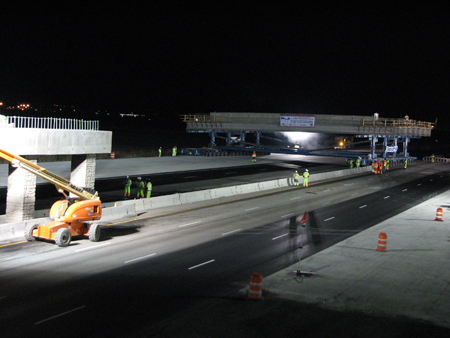U.S. Department of Transportation
Federal Highway Administration
1200 New Jersey Avenue, SE
Washington, DC 20590
202-366-4000
Focus
| Accelerating Infrastructure Innovations |
Publication Number: FHWA-HRT-12-009
Date: December 2011
Printable Version (.pdf, 1 mb)
From a bridge replaced in less than 3 days in Utah to 14 bridges replaced in 10 weekends in Massachusetts, more State transportation agencies are turning to accelerated bridge construction (ABC) using prefabricated bridge elements and systems (PBES) to shave valuable time off project schedules and greatly reduce the impact and inconvenience experienced by drivers.
While early initiatives focused on using specific prefabricated elements such as bridge decks or pier caps, recent projects have applied PBES and other ABC techniques to all aspects of bridge construction, from superstructures to substructures and foundations. To assist transportation agencies and contractors in implementing ABC, the Federal Highway Administration (FHWA) has released a comprehensive manual, Accelerated Bridge Construction: Experience in Design, Fabrication, and Erection of Prefabricated Bridge Elements and Systems (Pub. No. FHWA-HIF-12-013).
Following previous FHWA publications that looked at various aspects of PBES, such as the 2006 Decision-Making Framework for Prefabricated Bridge Elements and Systems (Pub. No. FHWA-HIF-06-030) and the 2009 Connection Details for Prefabricated Bridge Elements and Systems (Pub. No. FHWA-IF-09-010), the new manual presents a global overview on the current state of the practice for many of the major components used in ABC implementation. From project planning to construction to inspection, transportation agencies and contractors can find guidance on every step involved in using ABC and PBES.
"Designers and contractors can work together to optimize the advantages of ABC in meeting project needs," said Myint Lwin, Director of FHWA's Office of Bridge Technology.
ABC incorporates innovative planning, design, materials, and construction methods to reduce onsite construction time when building, replacing, or rehabilitating bridges. The use of PBES is a key element, as it offers both faster and safer bridge construction and better quality. Compared to conventional bridge construction methods, the use of PBES also improves mobility, reduces costs, and is easily adaptable to many site conditions.
The prefabricated systems can be manufactured offsite at a prefabrication plant or adjacent to the project site, under controlled conditions, and brought to the bridge location ready to install. Building in a controlled environment reduces weather-related delays and enhances constructibility, while also reducing traffic congestion and improving work zone safety. Using PBES can also reduce life-cycle costs and environmental impacts. Because of these advantages, FHWA selected PBES as one of the technologies promoted by its Every Day Counts initiative in 2010 (see June 2010 Focus).
In another benefit, States that have implemented extensive ABC programs have seen the public respond favorably to the greatly reduced inconvenience. The Utah Department of Transportation (UDOT) routinely measures public perception of construction projects through the use of post-construction questionnaires. Following one project that used ABC techniques, more than 97 percent of the respondents rated the project as a success.
Users of the new Accelerated Bridge Construction manual will find information on ABC techniques, including foundation and wall elements, rapid embankment construction, PBES, structural placement methods, and fast track contracting. Also discussed is the applicability of these techniques to different bridge projects, such as the rehabilitation of existing bridges and the construction of new bridges. The manual then takes transportation agencies and contractors through the decisionmaking process for selecting appropriate ABC methods. This process begins with defining the problem and then considers such issues as site constraints, staging areas, traffic management, right-of-way, utilities, local government constraints, and cost evaluation.
Prefabricated bridge elements are covered in detail, including materials, superstructure elements, substructure elements, and foundations. Also covered are bridge elements such as bridge deck expansion joints, bridge bearings, and barriers and railings. The manual then moves into the many aspects of the construction process, ranging from materials testing to fabrication and erection issues to shoring systems and grouting. Guidance is provided as well on field inspection, including staff training.
Also addressed is the long-term performance of prefabricated elements. Case studies examine the durability of joints in substructure elements and joints in precast concrete deck panels, while guidance is provided on the importance of inspection, preservation, and maintenance.
Design and analysis is covered in the final section of the manual, including incorporating the Load and Resistance Factor Design method and rating bridges using the Load and Resistance Factor Rating method (see November 2011 Focus). The appendices present design examples, information on standard and proprietary products, and sample construction specifications.
The manual also features a case study highlighting UDOT's experience in implementing ABC. UDOT first used ABC to complete several projects during preparations for the 2002 Winter Olympics in Salt Lake City. The success of these projects encouraged Utah to begin moving toward making ABC standard practice for all bridges. In 2010, UDOT met that goal and today, ABC is considered on all bridge projects and used where appropriate. Projects have included the 2007 replacement of the 4500 South bridge over the I-215 East Loop in Salt Lake City, which cut road closures and detours from 6 months to a single weekend and saved $4 million in road user costs. The success of this initiative brought momentum to UDOT's ABC implementation efforts and resulted in public support for innovative strategies such as ABC.
Included in the UDOT case study is a sample ABC implementation flow chart for a State agency. As the manual notes, while each agency functions differently and may need to modify the implementation approach to fit its circumstances, the chart presents the major activities that will help to produce a successful ABC program.
The Accelerated Bridge Construction manual is available at www.fhwa.dot.gov/bridge/abc/docs/abcmanual.pdf (.pdf, 13 mb). For more information on ABC, visit www.fhwa.dot.gov/bridge/abc/index.cfm. Information is also available by contacting Ben Beerman at the FHWA Resource Center, 404-562-3930 (email: benjamin.beerman@dot.gov).
FHWA's PBES deployment team can provide agencies with workshops and additional training focused on advancing PBES and other ABC technologies. "One of the deployment and implementation challenges with ABC and PBES is that there are many viable reasons to accelerate a single bridge project, group of projects, or an entire bridge program, and there are many viable options to consider to meet the objective," said Ben Beerman of the FHWA Resource Center. "For many agencies, it can be difficult to quickly identify which of all of the available options and techniques are better suited to meet their particular needs. The deployment team understands this and is happy to provide training and other assistance."
In addition to the recent release of the Accelerated Bridge Construction manual, the team will be facilitating regional Peer to Peer exchanges on PBES implementation in 2012, hosting monthly technical Webinars, and providing focused training workshops, presentations, and project-specific reviews. Focused workshops already held covered such topics as prefabricated substructures, ABC and PBES program implementation strategies, and the use of full-width and full-depth precast deck panels.
For more information on PBES/ABC deployment activities, sign up to receive email notices at www.fhwa.dot.gov/bridge/abc. To learn more about the assistance that the deployment team can provide, contact Ben Beerman at the FHWA Resource Center, 404-562-3930 (email: benjamin.beerman@dot.gov).

Accelerated bridge projects in Utah include the Proctor Lane bridge over I-15 in Utah County, which was constructed in 2011 (Photo © UDOT).

The Utah Department of Transportation installed the prefabricated superstructure of the 4500 South bridge over I-215 in Salt Lake City in 2007 (Photo © UDOT).

Following installation of the new bridge, I-215 reopened to traffic after a single weekend of work (Photo © UDOT).
